LPC Reacts Favorably to Proposal for New Pier 17 Building
Although a formal vote was not taken, the Landmarks Preservation Commission agreed yesterday to permit the demolition of the 1985 Pier 17 Building and allow its replacement with a glassy new building by ShoP Architects.
HDC opposed the proposal, stating that the building’s noted architect, Benjamin Thompson, made specific references to the South Street Seaport Historic District in his design, that the building’s gables, eaves and pitched roofs recall those of other existing buildings in the district as well as other important but long-gone structures such as the Fulton Ferry Terminal. Its metal material makes reference to other market buildings, most notably the neighboring Tin Building and WPA-era New Market Building. The open restaurants of the base harkens back to open market spaces and the upper floor decks provide space to enjoy river breezes and views much like pleasure parks on piers did a century ago.
HDC’s opposition to the demolition was supported by Phil Loheed, principal of Ben Thompson Associates (now BTA+) who worked on the design for the 1980’s transformation of the Seaport as well as Ben Thompson’s widow, Jane, who also worked on the Seaport plan. We were also joined by architectural historian Frances Morrone who said, “Whatever may have gone wrong with the marketplace, it wasn’t the architecture.” David Dunlap covered the story for The New York Times (it appears in today’s print edition and the slide show of his photographs online is well worth a look) and Christabel Gough of the Society for the Architecture of the City gave a stirring obituary for the building. Testifying in support of the new building were Manhattan Community Board 1, the Association for a Better New York, the New York Landmarks Conservancy, the Municipal Art Society, and a local business owner who wanted to ensure that “the right sort of visitors” would be attracted to the district.
One of the LPC commissioners asked the applicants whether retention and modification of the existing mall building was considered. After all, the new building is a mall as well, so reuse makes a certain kind of logic. The owner’s representative essentially said it couldn’t work for a number of reasons, although those reasons were not explained.
The commissioners spoke about their discomfort with their decision but repeatedly referenced “the trade off” of allowing demolition for additional public space and views of the Brooklyn Bridge. HDC finds this to be a peculiar reasoning, as much of the open space referenced in the new plan is either not in the historic district (and therefore shouldn’t be considered by the LPC) or of dubious access for the public (are you aware there is supposed to be public open space along the balconies of Grand Central Terminal?). Furthermore, currently accessible views of the Brooklyn Bridge (shown in Dunlap’s slideshow) will no longer be available, with the majority of viewing sites now being concentrated on the roof of the building which will have a combination of public and private uses.
Regardless of the rationale, the Landmarks Commission has now all but guaranteed that another protected landmark building will be demolished to enhance views of the Brooklyn Bridge. The first one to fall was the Purchase Building immediately underneath the Brooklyn Bridge, which was leveled in 2008 in order to produce what a parks planner referred to as “the money shot” of Brooklyn Bridge Park.
What is the lesson here? Obviously, the LPC, and the City, has a hierarchy of values, including weighing perceived social goods such as retention of history versus public accessibility (even if this access is questionable). This should come as little surprise to anyone with a passing familiarity with current events and municipal decision-making. More disturbingly, it would appear that the hierarchy of values also includes esthetics (again not surprising given the past furor about buildings such as 2 Columbus Circle). What is disturbing is that the decision-making at LPC can seem to be as prone to faddishness and enthusiasms as, say, the comments section of architectural news blog.
The Landmarks Commission has an incredibly important role in the life of our city. Within its narrow confines, the LPC gets to determine our shared historical memory. These decisions cannot and should not be made lightly. We are not advocating a “no growth, never change” policy nor are we implying that the individual commissioners did not struggle over this decision. However, given the public presentation to the LPC which we attended, we believe that a nicely-designed, contextual building which the Landmarks Preservation Commission deemed appropriate less than 30 years ago, was given little consideration and exceptionally short shrift.
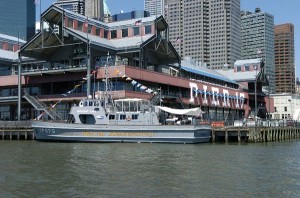
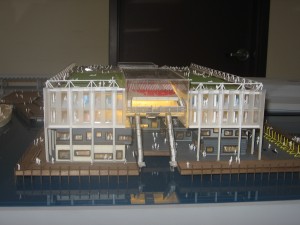
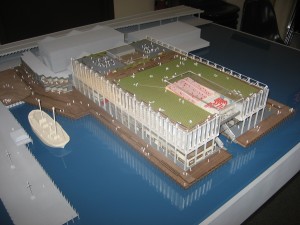
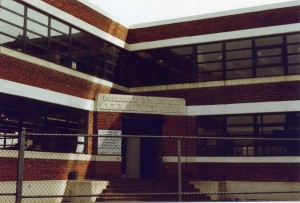
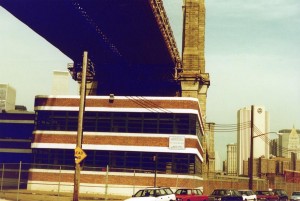
I agree that new proposal is a definite need for the area, in terms of new shopping, the ampitheatre and rooftop access. Yet, I feel the proposal is just a big box. Perhaps, if they integrated elements of how Pier 17 looks now like the large name on the sides or the triangular canopies, I might appreciated it more. And the proposal to just call it “The Seaport,” I don’t understand why developers and architects are obsessed with common names. It’s Pier 17 or South Street Seaport, just call it as it is. There is such a thing as being overly chique.
I agree that new proposal is a definite need for the area, in terms of new shopping, the ampitheatre and rooftop access. Yet, I feel the proposal is just a big box. Perhaps, if they integrated elements of how Pier 17 looks now like the large name on the sides or the triangular canopies, I might appreciated it more. And the proposal to just call it “The Seaport,” I don’t understand why developers and architects are obsessed with common names. It’s Pier 17 or South Street Seaport, just call it as it is. There is such a thing as being overly chique.